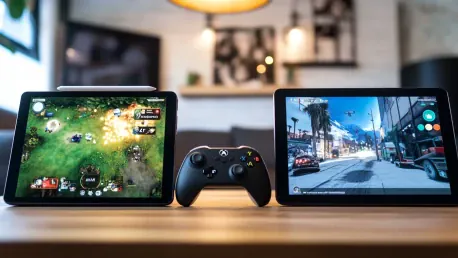Gaming tablets are poised on a unique precipice as we venture into 2025, with the dual pressures of a booming mobile gaming sector and the increasing sophistication of dedicated handheld gaming devices. The landscape has evolved significantly, driven by the new demands and capabilities of gamers worldwide. As mobile gaming continues to grow at an unprecedented rate, tablets have struggled to keep pace but remain a crucial player in this dynamic environment.
The Rise of Mobile Gaming
Explosive Growth and Market Dynamics
Mobile gaming has experienced astonishing growth in recent years, with an ever-expanding player base and surging revenue generation. This momentum is fueled by initiatives like Microsoft’s push to turn ordinary devices into gaming platforms, marking a profound shift toward more agile and portable gaming experiences. The convenience of playing complex games on the go, anytime and anywhere, is becoming an expectation rather than a luxury, hinting that the era of gaming tied exclusively to household consoles may soon be obsolete.
As mobile gaming increases in prevalence, the demand for powerful and versatile devices that can seamlessly support these experiences intensifies. Yet, in this rapidly evolving landscape, gaming tablets don’t solely reap the benefits of advancements in technology. The rise of dedicated handheld gaming devices, capable of delivering top-tier Triple-A game experiences, has created formidable competition. Despite facing this intense rivalry, top-tier gaming tablets have maintained their position in the market, albeit with significant challenges. Their journey highlights a story of resilience and adaptation within a highly competitive niche.
Tablets vs. Handheld Gaming Devices
Tablets, with their larger screens, more robust RAM, and extended battery life, present several key advantages over mainstream smartphones for gaming. These attributes make them particularly suitable for more demanding gaming experiences. However, the overall market growth for tablets has been less than stellar. For instance, leading brands like Apple and Samsung saw significant declines in tablet shipments during 2023, contributing to a mixed outlook for the future. Such data reflect the broader uncertainty and fluctuating consumer interest in these devices.
On the other side of the spectrum, dedicated handheld gaming devices have managed to captivate a solid section of the gaming market. These devices specialize in delivering immersive, high-quality gaming experiences, often making them the preferred choice for dedicated gamers. Still, despite these formidable competitors, gaming tablets leverage their versatile use case and inherent hardware strengths to secure their niche position. Their struggle underscores the larger trend of convergence and differentiation within mobile gaming technologies.
Advantages and Challenges of Gaming Tablets
Superior Hardware Capabilities
In the face of stiff competition, gaming tablets boast certain hardware capabilities that set them apart. These devices generally feature larger screens which provide an enriched visual experience compared to smartphones. Plus, with enhanced RAM capacities, they can handle intensive gaming sessions more efficiently. Their superior battery life ensures longer play times without frequent recharges, which is a critical factor for gamers who favor extended sessions. These hardware advantages undeniably make tablets a viable option for more immersive gaming experiences.
Yet, the market for tablets has shown only modest growth, reflecting the challenges these devices face. Recent data from 2023 indicated that tablet sales for major brands experienced significant contractions, with Apple and Samsung observing declines of -29.3% and -6.6%, respectively. This downturn highlights consumer hesitance and market saturation issues that tablets currently grapple with. Interestingly, while mobile gaming revenues only saw a slight dip (-2.1%) in the same timeframe, it underscores the resilience and adaptive nature of mobile gaming itself.
Market Trends and Recovery
Despite such setbacks, both the tablet and the mobile gaming sectors have managed to recover, albeit at different paces. Mobile gaming, due to its ubiquitous nature and ease of access, has seen a faster recovery rate compared to tablets. Projections estimate that by 2029, the global mobile gaming audience will reach approximately 2.4 billion users, growing at an annual rate of 5.56%. In contrast, the tablet market will expand at a slower rate of around 2.82%, hinting at a more gradual resurgence.
Forecasts suggest a future where mobile gaming’s expansion will be driven jointly by smartphones and tablets. However, the advent of new and improved gaming handheld devices, alongside anticipated releases like the next Nintendo Switch, casts a shadow over the future prospects of gaming tablets. Nonetheless, tablets are predicted to remain pertinent due to evolving gaming trends and the rising popularity of certain categories of games and services. This nuanced dynamic underpins the complex interplay of market forces shaping the future of gaming tablets.
The Role of Mid-Market Games and Streaming Services
Emergence of Mid-Market Games
A significant trend that could aid the sustained relevance of gaming tablets is the re-emergence of mid-market or Double-A games. Titles such as “Hellblade: Senua’s Sacrifice,” “Lies of P,” and “It Takes Two” exemplify this category well. These games, while not as extensive or high-budget as Triple-A blockbusters, still offer compelling visual and gameplay experiences. Their medium complexity makes them especially suitable for tablets, aligning well with consumer desires for great gaming experiences without necessitating the highest-end hardware.
This trend indicates a revived consumer interest in high-quality gaming that remains accessible on more versatile devices. Platforms like Apple’s Arcade increasingly feature these mid-market games, including prominent titles like “Alien Isolation,” “Monster Hunter Stories,” and “Divinity Original Sin 2.” These offerings serve as a testament to the viability of tablets as capable gaming devices that cater to a broad audience. Their acceptance implies a continued, though perhaps niche, segment where tablets can thrive.
Impact of Streaming Services
Another pivotal consideration in the future of gaming tablets is the impact of streaming services. Reflecting on their controversial yet rapidly growing influence, streaming services like Microsoft’s Game Pass, PS Plus, and Amazon Luna offer unparalleled gaming convenience. They enable users to stream a wide array of sophisticated games without the need for heavy investment in hardware, fundamentally altering the gaming ecosystem.
The improvements in internet speeds and advancements in server technologies bolster these services, making them increasingly accessible and reliable. For modern gamers, the allure of streaming lies in its flexibility and reduced need for powerful physical hardware, transforming practically any device into a capable gaming platform. While laptops and smartphones can access these streaming services, tablets stand out due to their screen sizes and portable nature. This intersection of technology and consumer behavior points to a strategically significant role for gaming tablets in the streaming domain.
The Challenge of Dedicated Gaming Handhelds
Superior Gaming Experience
Despite the advantages and evolving capabilities of gaming tablets, they face a formidable challenge from dedicated gaming handhelds. These devices, designed explicitly with gaming in mind, often surpass tablets in functionality and performance. Integrating features such as built-in controls, gaming-specific screens with high refresh rates and Variable Refresh Rate (VRR) options, optimized graphics processors, and customizable power and cooling settings, these handhelds deliver an unrivaled gaming experience for users demanding peak performance.
Gaming handhelds’ inherent advantage lies in their focused design, which directly caters to the specific needs of gamers. Their development prioritizes aspects of gameplay, rendering them more adept at providing an immersive and satisfying gaming experience. This specialization places them at a distinct advantage over gaming tablets, which, despite superior general-use hardware specifications, must balance a broader range of functionalities. The emergence of numerous new handhelds has introduced a fresh competitive dynamic, heightening the competitive stakes in the portable gaming market.
Consumer Decision-Making
In deciding between a gaming tablet and a dedicated gaming handheld in 2025, the broader needs and preferences of consumers play a crucial role. For users seeking a device primarily for everyday tasks like web browsing, video streaming, note-taking, and occasional light to moderate gaming, a gaming tablet proves to be an efficient and rewarding investment. Contemporary tablets accommodate various uses and continue to serve effectively with adjuncts like Bluetooth controllers and improved on-screen controls, particularly appealing to casual gamers desiring a multi-functional device.
Conversely, for consumers whose foremost interest is an optimal gaming experience detached from a dedicated TV setup, gaming handhelds emerge as the preferred choice. These devices, with their dedicated hardware and superbly integrated controls, are tailored to deliver a more engaging and high-quality gaming experience. Handhelds offer the best of gaming technology in compact and versatile packages, marking them as superior for enthusiasts seeking performance and immersion. This dichotomy in consumer decision-making underscores the divergent paths that gaming tablets and handhelds will likely take in the near future.
Additional Portable Gaming Options
Gaming Phones and Accessories
As we approach 2025, gaming tablets find themselves at a critical juncture, facing two distinct pressures: the rapidly expanding mobile gaming sector and the evolving sophistication of dedicated handheld gaming devices. This landscape has seen considerable change, spurred by the demands and advancements of gamers everywhere. Mobile gaming has grown at a breakneck speed, outpacing other forms of entertainment, and tablets have had a tough time keeping up. Despite these challenges, they remain an integral part of the gaming ecosystem.
Tablets have always offered a blend of portability and performance that caters to casual and mid-core gamers who seek more than what smartphones offer but aren’t completely sold on the specialized handheld consoles. With larger screens and better battery life, gaming tablets present a compelling option for on-the-go gaming. However, they’re not without competition. Dedicated handheld gaming devices have also advanced, providing robust gaming experiences that tablets struggle to match. Therefore, as the industry grows and competitions heat up, the role of gaming tablets will continually evolve, driven by technological innovations and consumer preferences.









